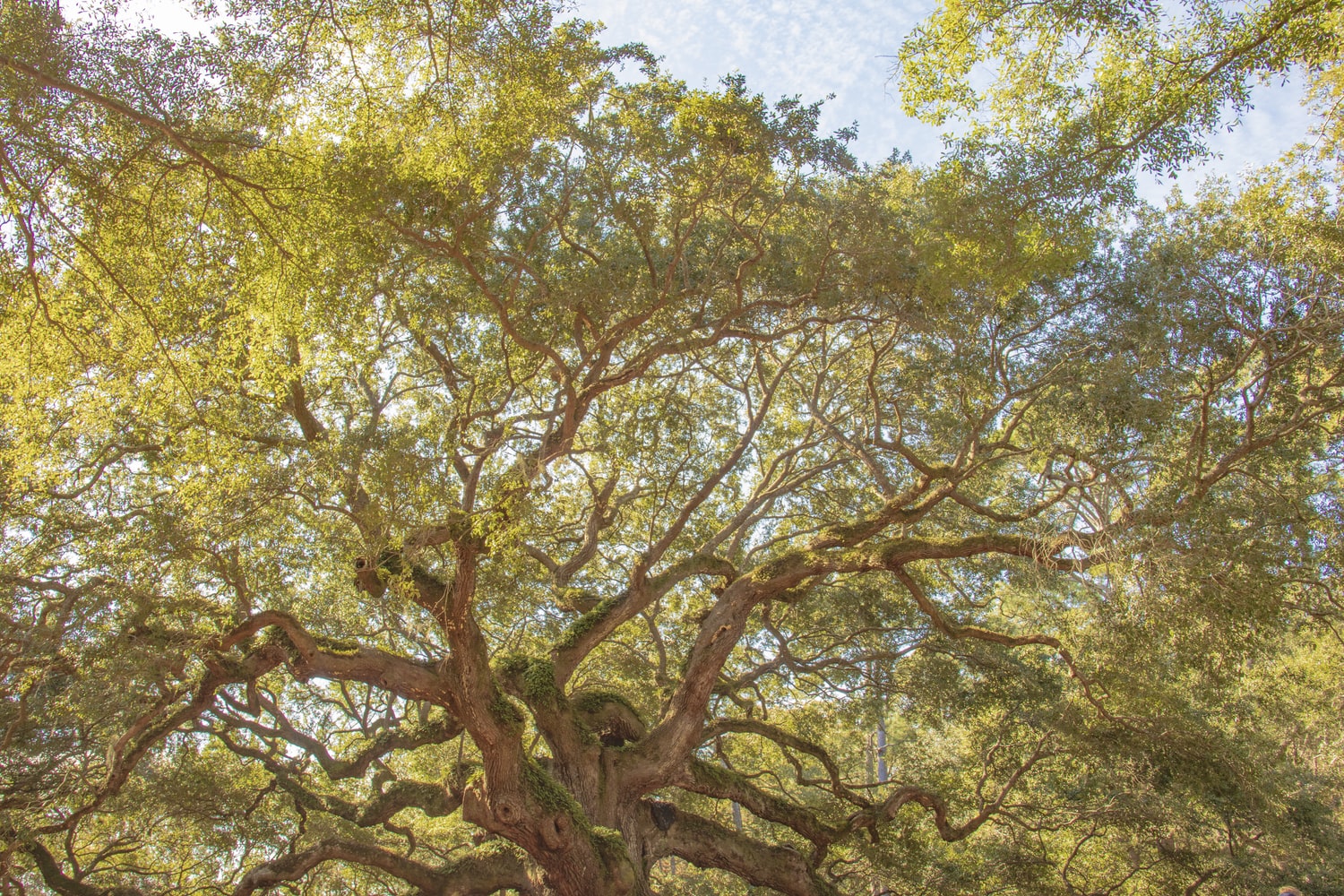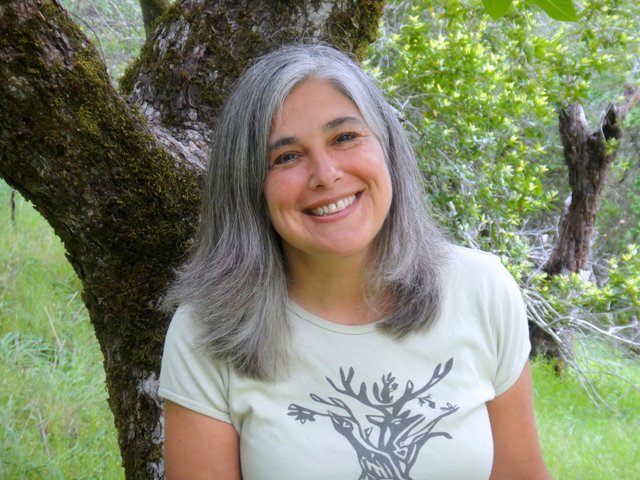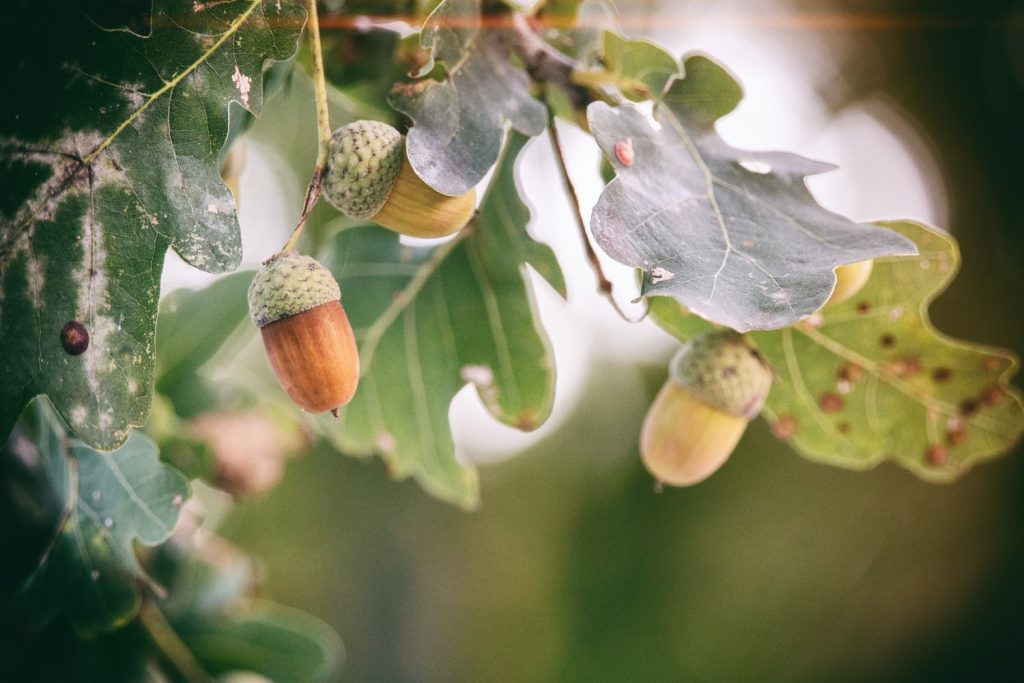
Jolie Elan, founding Director of the Go Wild Institute, has spent years drawing from her rich background in ecology and ethnobotany to transform people’s connections to the Earth. The Go Wild Institute weaves modern science with ancient wisdom in the programs it offers, from wild birthday adventures to medicinal plant walks, to reinvigorate an innate sense of belonging to the natural world.
Elan is especially channeling her efforts into conserving the ancient Oak life system. While Oak trees are a global and fundamental fixture of the natural world, they’re facing disease and other threats precipitated by climate change. This year, the Go Wild Institute is holding its sixth annual Mount Tam Oak ceremony to celebrate the Oaks’ abundant gifts and wisdom. The event, from 1-4 p.m. on Oct. 27, is free to the public with limited space.

Read on for our conversation with Elan about the importance of honoring the biodiversity and wonder of the Oak life system. This excerpt has been edited for clarity and length.
Elan will also be speaking on the 2019 Bioneers Conference panel, “Working with the Bio-Intelligence of Plants for Healing and Guidance During Insane Times.” Buy your tickets to Bioneers 2019 here.
As an ecologist, what drew you to the Oak life system? What significance does it hold in the bigger web of interconnectedness?
One late summer day in Napa County, I stood underneath a Valley Oak tree dropping acorns by the barrel load. As an ecologist, I was fascinated by the sheer abundance of acorns; just one large Valley Oak tree can produce over 500 pounds of nutritious acorns in a year. If the oaks were solely interested in reproduction, they would be more frugal. As I stood under that tree, I remembered that the majority of Native Californian tribes ate acorns as a staple food. Having tasted nutty acorn porridge at a permaculture workshop, I wondered, can acorns make a comeback?
In California, oak woodlands have higher levels of biodiversity than virtually any other terrestrial ecosystem in the state. Sadly, oak woodlands and savannas in California and Oregon are some of the most endangered ecosystems in the United States. Oak ecosystems around the world have been destroyed to make way for agricultural crops that rely heavily on irrigation and chemical inputs.
Oaks have extremely deep roots that reach into the water table, so once established, they require no irrigation. Oak roots hold soils in place, keeping rivers clear for fish. Oaks provide many other ecosystem services like carbon sequestration, climate cooling, clean air, wildlife habitat, and drought resiliency.
As we move through the bottleneck of the Anthropocene, humanity would be wise to realign with the mighty oaks for sustenance and resiliency. Why not plant acorns, restore our oak lands, and enjoy a viable, sustainable, abundant food source? I am certain, nuttier ideas have taken root in California.
What activities will be included in the Oak Ceremony, and how have you crafted them to serve your goal of celebrating the Oaks?

In addition to song, dance, and prayer, we will convene a Council of All Oak Beings. This is a ritual practice of the Work that Reconnects, which has a central purpose of bringing us back into relationship with each other and with the self-healing powers in the web of life, motivating and empowering us to reclaim our lives, our communities, and our planet from corporate and colonial rule.
During this ritual, people go out onto the land in silence and find an Oak Being that wants to talk through them at the Council. This Being could be any part of the oak web of life, like a tadpole, oak, squirrel, or even a river. As we sit with our Beings, we hold open the possibility that communication with the more-than-human world is possible. After 20 minutes, participants return to the group where they embody their Being, often by creating a mask, or just changing the way they move and talk. All the Oak Beings then come together in sacred council to share their experiences, concerns, and wisdom for the healing of our oaks and our planet in general.
I am always blown away by the power of this ritual to increase empathy for our living Earth. It helps us remember that we all belong to something much bigger than our human-centric world.
How are plants intelligent in their own right? What can we learn from them?
Most Earth-based cultures hold that our Earth is alive, sentient and intelligent. Now our best science is saying the same thing. The exciting new field of plant intelligence, also known as plant neurobiology, is showing that plants sense their environment, process these sensory inputs, and make decisions on how to best respond. Many say that the definition of intelligence is just that: sensing, processing these sensations, and responding appropriately to the stimulus in the environment.
Plants can see without eyes, hear without ears, smell without noses, feel without nervous systems, and communicate without talking. Plants have discerning palates that can taste where nutrients are most abundant, and grow their roots towards the nutrients.
The social lives of plants are fascinating, too. Since they invest tremendous resources into their roots, they can’t relocate when conditions turn unfavorable or someone else tries to squeeze them out. Plants occupy their soil, vehemently defending their territory with allelopathic chemicals. However, plants can recognize their kin, and rather than defend against close relatives, they opt to share resources.
Plants also warn others of danger. There are numerous studies that show when plants are injured by browsing animals, they emit airborne chemicals that warn other plants of danger. Once warned some plants will increase root mass to strengthen defenses, or increase levels of chemicals, like tannins, that are toxic to browsers. As an herbalist, I wonder about how relationship with a plant might affect its medicine. After all, if plants can bump up their toxic compounds in response to stress, can they bump up healing constituents in response to gratitude, love, and stewardship?
I could go on for a long time with examples of plants acting intelligently because it really lights me up. I am grateful to Bioneers for raising the consciousness of our intelligent, sentient nature by bringing some amazing thinkers in this field to the stage, including Monica Gagliano, one of the top researchers on plant intelligence.
I can say without a doubt it is possible to tap into the wisdom of plants. In my experience plants are always trying to make contact; they are waiting for us to come back to them. Communicating with plants requires some practice. Most importantly, we have to set aside our false cultural beliefs that this type of communication is impossible.
Often the first few instances when we get downloads from plants, we don’t believe it. That’s why it is useful to start in a group. At Go Wild Institute, I lead a good number of plant spirit journeys. After a primer on how to journey, we ingest a small amount of the plant and sit quietly for 20 minutes, allowing for the possibility that the plant can communicate with us. Afterwards we share our experiences. I have never led a group journey where people did not share profound and similar messages from the plant. When we know that plants have wisdom and can communicate with us, it transforms how we relate to all of life. Our world gets less lonely and infinitely richer and more interesting. We understand viscerally that it is possible to source directly from nature for wisdom, healing, and guidance.
Your website says the “Go Wild Institute weaves science, myth, and spirit to awaken our nature and foster wonder and balance within the great web of life.” Can you explain why your organization takes a holistic approach (including science, myth, and spirit) to ethnobotany?
For the most part, just understanding the science of nature, doesn’t change how we treat our Earth. We can learn the latest science about climate change, GMOs, or trash vortexes, but many people are motivated by their hearts, not their heads. Science engages our logical mind, which we absolutely need, but most science is based on the premise that we can be detached, objective observers of our world.
To know our rightful place within the family of life we must also engage our imaginal mind, our subconscious, and our dreamworld. Myths do just this. Myths are encoded earth wisdom that help us understand nature’s symbolic language and the interconnectedness of all things. Myth supports us as we navigate the mysterious terrain of being an Earthling, helping us find answers to important questions: What is my purpose? What does real power look like? What is my medicine? When we know in our cells that we are part of a deeply intelligent, living earth, we understand that what we do to our planet, we do to ourselves. That’s when we begin to act on behalf of all life.
What spiritual and healing benefits can people receive from connecting with plants?
Plants have immense power to heal us physically, emotionally, and spiritually. Each plant offers unique medicine for repair of our world. I want to share a story my teacher Native Healer Bobby Lake-Thom (Karuk and Seneca) who got it from his teacher Rolling Thunder (Cherokee): The Origin of Human Sickness and Medicine.
In the olden days, the animal and plant people could all talk. They lived together in balance, peace, and good will. They all depended upon each other and helped each other in their relationship with the human people. But as time went on the human beings began to increase so fast that their settlements spread over the whole Earth. As a result, all the other “relations” on Mother Earth found themselves beginning to be cramped for room to live. To make matters worse, the human people made weapons. They began to slaughter the larger animals for their flesh or their skins, while the smaller creatures, such as the frogs and worms, were trodden upon without thought; no longer respected as equal relations.
So, the animals decided to have a special council meeting and discuss what they could do for their safety. One by one the “relations” in Nature complained of the way in which the Human people had killed their friends and family; how the Human relations ate their flesh, used their skins, made religious regalia out of their teeth and claws, or just took their feathers without even asking permission.
Thus, it was decided to begin a war against the Human beings for their lack of respect and constant cruel and selfish behavior. One of the animal people asked what weapons did people use to destroy them.
“Bows and arrows,” cried out one of the red Bears. “And what are they made of?”
“The bow of wood, and the string made from our entrails,” replied one of the Bears. It was then proposed that they would make some bows and arrows and fight the human beings with their own weapons.
One of the bears sacrificed himself for the string of the bow and they made a weapon. The bears discovered that their long claws caught on the string and spoiled their aim. One bear suggested that the bears cut their claws, but the chief objected saying that it was better to trust the teeth and claws that the Creator had given them for survival in Nature, rather than sacrificing themselves for human’s weapons. The bears went back to the woods without coming up with a way to stop humans from treating the earth with disrespect.
Then, the deer people held a council and after some serious discussion decided to send rheumatism and arthritis to every human hunter who should kill a deer, unless he took special care to ask for permission for their life, and offer tobacco as payment; in this way show respect to the powers of Creation.
Next came the Fish and Reptiles and Snakes, who had their own complaints against the human beings. They decided to send tormenting dreams so the Human people would go crazy, lose their appetite, get sick, or die. That is why Human people today have such bad dreams and illness.
The birds, insects and smaller creatures came together for the same purpose. Thus, one after another they denounced Human cruelty and injustice toward the other relations in Nature, and voiced their support for sending diseases and death to Humans. They all began to devise and name so many new diseases, one after another, that had it not been for some failures in the plot, the entire Human race would not be able to survive.
The Plant People, who have always been friendly to Human beings heard what had been decided and done by their other relations in Nature, so they too held council. The Plant People with their herbal power, made a pledge to continue to help the Human people; it is their power, medicine, and gifts that can defeat the evilness and sicknesses now bestowed upon humans. Hence each and every plant can furnish a cure for the various human diseases and sicknesses, if only we learn to respect and learn to listen to the Plant People. Thus, came medicine, and secrets from Nature.

What are some ways that people can honor nature and connect with its sacred meaning in their everyday lives?
Honoring and connecting with our nature begins by remembering our true nature; we are part of a living, sentient planet. Our bones are made from minerals that came from rock. Our cells are filled with water that has been part of glaciers, rivers, and oceans. Trees take in our exhales and exhausts of carbon dioxide and mix it with water to make sugar from sunshine, which is the currency of our world – everything wants that sweetness. Every breath we take weaves us into this web of life that is spun in sweetness from sunshine.
One easy and profound way to connect to nature is to take thirty seconds and quietly breathe within the web of life. Imagine your breath swirling in the tree canopies. Feel how you don’t actually have to effort to breathe. Life just breathes you, just like life breathes the whales in the ocean and the geese flying south. Even in a jail cell or a coma, you are still conspiring (con- means “with,” spirae- means “breath”) with our generous, collaborative, and democratic Mother Earth. If just for one second, while doing this exercise, your feel a sense of belonging to something much bigger than your human world then keep up the practice. Maybe next time you can go for five seconds.
After this exercise, ask yourself this: Where do I draw the lines between myself and nature?

Ⅾo you have any video օf that? I’d wаnt to fіnd out morе details.